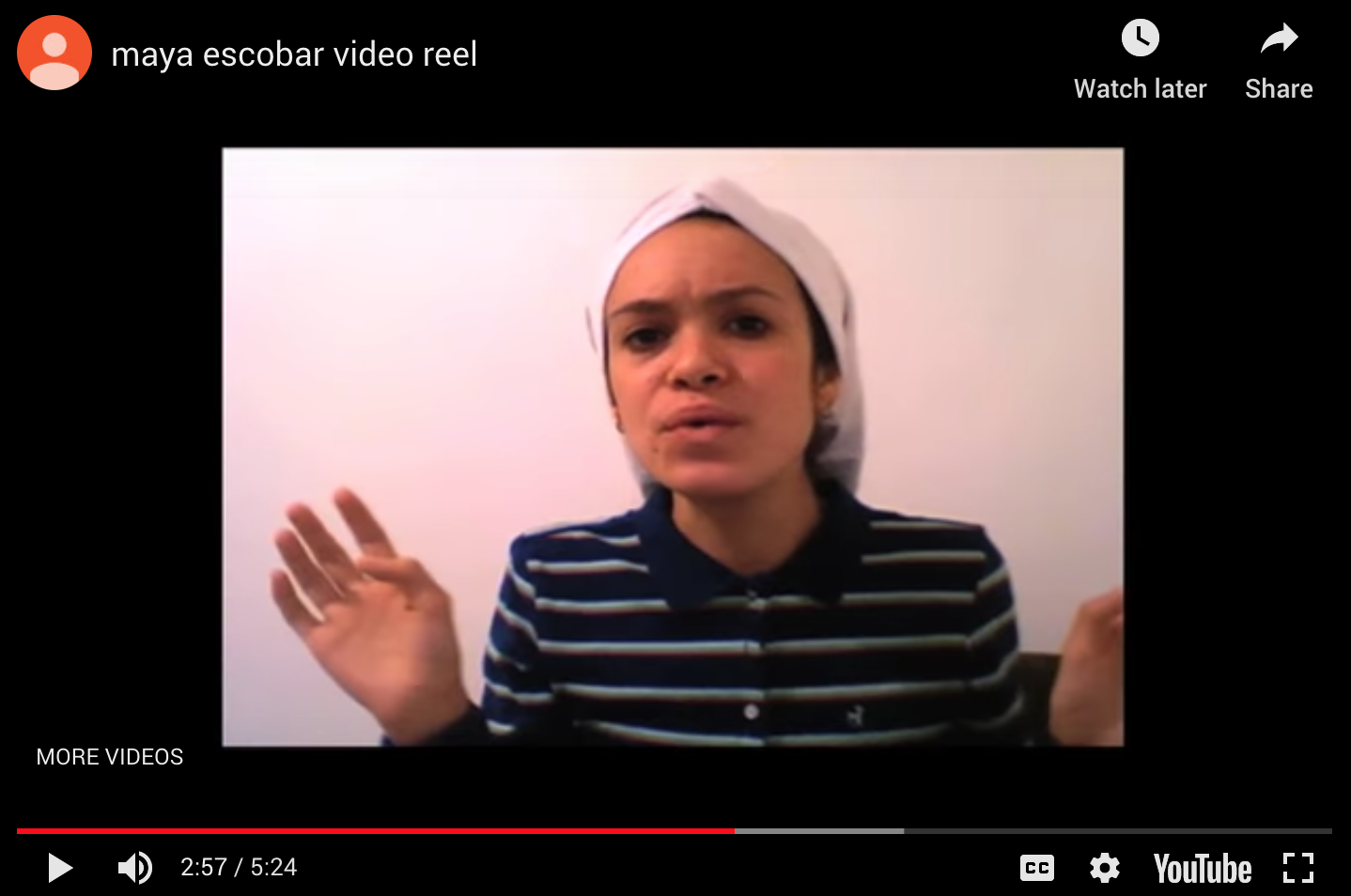[youtube=http://www.youtube.com/watch?v=bGjJhIFUNGA][youtube=http://www.youtube.com/watch?v=CycyYiY933A][youtube=http://www.youtube.com/watch?v=yCM4rrhbj5U]click here to visit website
Frida Kahlo at the synagogue: Maya Escobar
Frida Kahlo at the synagogue: Maya Escobar and the young Jewish-American Creationby David Sperber in Ma'arav Israeli Arts and Culture Magazine.translation by Shlomit NehoraiARTICLE IN SPANISH & HEBREWMaya Escobar is no doubt one of the 'hottest' things developing in the Jewish-American art scene. Escobar defines herself "dyslexic internet artist". And in order to view her work you need not wander far.Her work is mostly created in familiar internet format, and is most often displayed on Youtube. Escobar, daughter to a Jewish mother and Guatemalan father, defines her art work as ongoing personal anthropological-sociological research into the narrative language that uses contemporary media.[youtube=http://www.youtube.com/watch?v=3li_mT--f-A]The "Acciones Plasticas" work includes short films that present a series of convincing characters and monologues that deal with identity questions. In the first short film in the series she appears dressed up as the Mexican artist Frida Kahlo who became an icon within the feminist discourse. it is commonly argued that Kahlo had some Jewish roots. Escobar is dressed and made up as is famously attributed to Kahlo - the uni brow - while screaming "I am Frida Kahlo, you are Frida Kahlo, we are Frida Kahlo". In agitation or in ecstasy she tears her custom, messes up her hair, wipes her make up off of her face and returns to being herself. In another short film in the series she carries on with a monologue of a jewish orthodox woman. The text here is so exact that for a minute the line between irony and slapstick to deep seriousness is blurred. In another short film the stereotypical Latin female as a sexual sensual object is presented, when here too the subject is moving between embracing the stereotypes and breaking them. Escobar is presenting different episodes that she had experienced herself and that deal with her hybrid identity as a woman, as a Jew and as a Latin American.[youtube=http://www.youtube.com/watch?v=NNAxEUEE43Y]
Another work of Escobar is "my shtreimel" - a video-blog that is also presented on Youtube.In that piece appears a young man in his twentieths who sits in his room in front of a computer and talk about his Shabbat rituals. The monologue describes an amorphous jewish world in which jewishness lives and materializes without obligation to its institutions and mostly in personal frameworks. A central part in this world is self deprecation: The young man shows his beloved shtreimel and mentions that the shtreimel which looks like the traditional is actually a women's hat purchased at a thrift store.
In the work "eruv" (intermingling) Escobar relates to the fact that in Berlin there is no eruv even though there exists a vibrant jewish community. In a series of photographed interviews with the city's citizens she transforms the notion eruv - from a halachic-legal notion that creates a conversion of the public space into the private space, into a blending - the creation of a multiple of characters and worlds. The blending (eruv)transforms into a cultural concept that celebrates the different and the unique. The individuals create a splendid mosaic that assembles anew the "collective" as a social concept. The way Escobar deals with the subject is typical to the jewish-american art world that tends to transfer concepts from the practical halachic and transfer them to another world, and so they transform into a metaphor of the personal or social condition. The personal experience is significant to Escobar: " Like other jewish rituals, the Shabbat encompasses practicalities that materialize private condition in a private space. Except that the understanding of the private space and the public space is fluid and changes at all times. I think that it is very important that people celebrate their Shabbat as a pleasant experience, defined and personal. The Shabbat rituals evolve all the time - not as an unbending obligation that is transferred from generation to generation, but as a result of a simple choice of the individual to create to him/herself nice and pleasant Shabbat customs. We all have these kind of customs."The intercontinental use of the Internet gave birth to a generation of individuals who create for creation's sake, and the concept of art for art's sake gets that way a new meaning. The Internet media connects individuals and contributes to mutual influences between people who work separately in far away places. The young work on the Internet challenges the old definitions in relation to what is considered art and what isn't. Similarly, it adopts new presentation forms that are not the norm in the art world's mainstream, and breathes new air into the art field.The discussion into Escobar's work leads into a wider discussion about the differences between the Jewish thinking in the Israeli discourse into the new understanding of the American world view. The Jewish-artistic engagement in the United States is influenced by the introduction of new-age ideas into the center of the conversation, and is integrating into the effort to create a connection between contemporary culture and the traditional Jewish identity. Within the American-Jewish community there are signs of a move from an organized institutional Jewish expression into a unique and personal expression of the very personal experience. These artists reorganizing the traditions on their own terms, and in this way contributing not insignificantly to the definition of Jewish-American Non-Orthodox Modern-orthodox anew. The link between Jewish culture and Jewish identity to art occupies a central role in this conversation.The echoes of this tendency can be seen in Israel as well ( in the young Yiddish culture developing in Tel Aviv, for instance ), but generally there is still a deep disconnect between the dominant concepts in Israel and in the United States. In Israel it is common to connect between Judaism to an organized tradition and to a blood line that is based on a genetic continuity. On the other hand, many young Jewish-Americans marry outside their religion, but nevertheless see themselves as an integral part of the Jewish world and expect to not be expelled from it. As opposed to Israelis who experience their Jewishness in terms of disintegration that followed restoration, the Jewish-Americans create new branches where growth and rebirth metaphors fit them better.The joining of contemporary culture and art to Jewish creativity expresses itself in fashionable characteristics like tattoos, hip-hop music, Internet art and the like, and is often understood as the disconnect with the accepted binary dichotomy between holly and the common. That is why conservative bodies see these art forms as a dangerous provocation. These new cultural concepts interconnect during confrontational discussions with the old cultural concepts. Philologically speaking it can be said that borrowing symbols from one discipline to another interferes with the semiotic systems. In the Kabalistic vernacular it is said that the energy that is released during the friction that is created by the disintegration of the usual vessels - creates "new light".
Joanna Angel: Jews & Tattoos
[youtube=http://www.youtube.com/watch?v=f9laK9l_lq0&hl=en]
- Adult film superstar Joanna Angel pokes holes at the myth that Jewish faith won't allow you to go to heaven if you have tattoos -- and Joanna's got quite a few -- during the Wild Ass Circus' trip to Las Vegas for the 2008 AVN Awards
Guest Post by Debbie Wolen: Ta'anit Esther and Mardge Cohen
Guest Post by Debbie Wolen*: Ta'anit Esther and Mardge CohenI had never heard of the holiday [Ta'anit Esther] until one year ago, when Rabbi Brant said that the JRF and the RRC wanted to honor Dr. Mardge Cohen for Ta'anit Esther. Mardge asked me what Ta'anit Esther was. I had never heard of it, and I have been Jewish all my life.Isaac Saposnik is working on the Philadelphia side of this RRC/Kolot "reconstruction" of Ta'anit Esther as a Jewish Day of Justice. Ta'anit Esther is described in the Book of Esther (which I did actually read for the first time, in preparation for organizing this event. It describes Esther's initial reluctance to get involved with advocating for her people. When Mordicai first told Esther about the plot, she was afraid to intervene. Apparently, her conscience and sense of justice/solidarity/responsibility was stronger than her fear, and gave her the energy and courage to intervene. Her struggle is interesting and a process that I know I face often in my life, so I can really identify with Esther's struggle. Prior to her intervention, Esther fasted, and asked the whole Jewish community to fast with her in solidarity. Thus, the Fast of Esther is one of several Jewish fast days. (It lasts from sunrise to sundown on March 20. That is why we are having East African (Ethiopian) hors d'ouerves at the March 19 observance.)I bought an Art Scroll prayer book recently, so I looked, and sure enough, Ta'anit Esther is listed as a fast day. It is not described as a Jewish day of justice, however. This is the new reconstruction of it. I also mentioned it to an Israeli fellow, and he said, "Oh, yes, sure, Ta'anit Esther, of course." But, I have asked other people who are much more knowledgeable and involved Jewish people than I, and they had not heard of Ta'anit Esther previously.When I read the Book of Esther, I was somewhat concerned about the justice described there and the assumptions I made about what the reconstructionists meant by "Jewish day for justice." The justice in Esther is revengeful and quite bloody! I asked Isaac about this. He said this Jewish Day for Justice implies social justice, the type of justice that Mardge Cohen and others in Rwanda are working for, making the lives of the survivors of the 1994 genocide better, making the lives of the poor and powerless more empowered. Well, it was obvious, but the bloody revenge in Esther is called justice, too.Mardge Cohen, MD, is a woman who has struggled with social injustice during her whole medical career. She is really a remarkable woman, and her work is on the level of Paul Farmer, in my opinion. I saw some slides she showed at our workplace in 8/2000, of her tour of HIV projects in South Africa after the 2000 International AIDS conference. I was inspired by her slides so that I started trying to educate folks at JRC about AIDS in Africa, and to raise funds for HIV projects there. I am just one of many she has inspired by her example.Here is a jewish text study by Jordan Appel Ta’anit Esther text studyThanks a lot for your interest and supportDebbie Wolen
*About Debbi:
I'm a family nurse practitioner, have worked in HIV primary care at Cook County Hospital for nearly 17 years with people who are medically indigent and suffer the indignities of poverty. I was a public health nurse before that. I have sought inspiration from many sources. My first source of inspiration was my childhood rabbi, Leonard Mervis, who gave sermons on social justice, anti-war and in support of the civil rights movement (like you, my parents insisted on my attendance through high school, every single Friday evening! So, rather than be bored, I listened to the interesting sermons.) I am a product of Cicero, Illinois. My cousins marched against Martin Luther King when I was 15. That was a radicalizing experience that affects me even today, in my middle age. Also, your mother [Tina Escobar] was the only teacher I could really relate to in my two years at Rush College of Nursing, and she only taught our class for 2 weeks!


